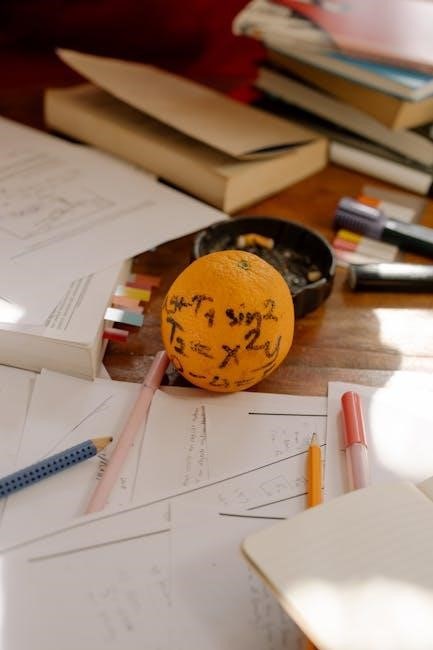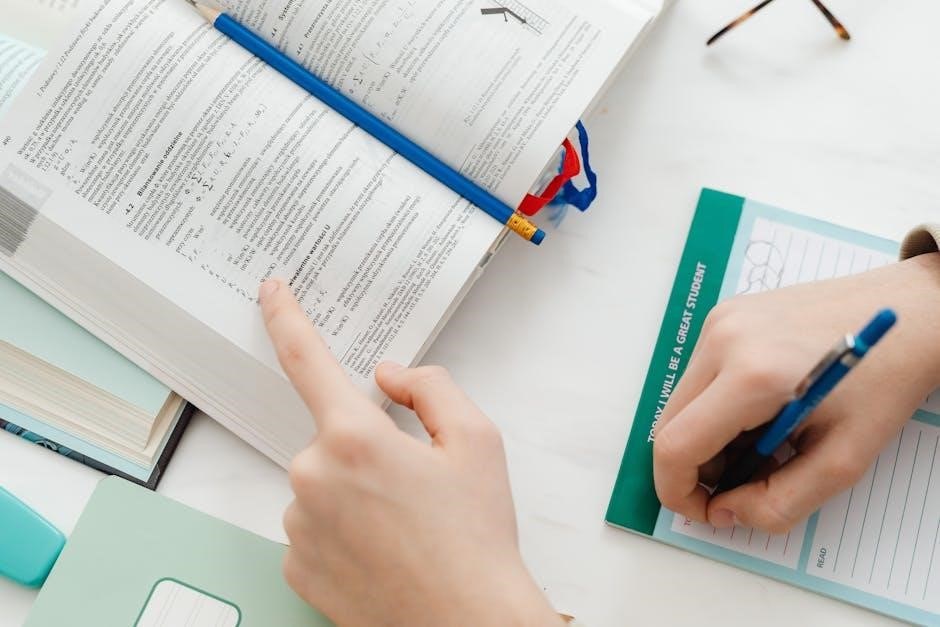australian curriculum maths year 7 textbook pdf
Download the Australian Curriculum Maths Year 7 textbook in PDF format instantly. Perfect for students and educators!
Overview of the Australian Curriculum Maths Year 7 Textbook
The Australian Curriculum Maths Year 7 textbook is designed to build foundational skills in number, algebra, geometry, and statistics. It aligns with ACARA standards, providing clear explanations and practical examples to enhance mathematical understanding.
The Australian Curriculum Maths Year 7 is structured to develop essential mathematical skills and understanding for students transitioning into early secondary education; It focuses on fostering problem-solving abilities, critical thinking, and the application of maths in real-world contexts. The curriculum is divided into key areas: number, algebra, geometry, measurement, and statistics. Each strand is designed to build upon previous knowledge, ensuring a progressive learning journey. The Year 7 program emphasizes the development of mathematical fluency, reasoning, and communication skills. Students are encouraged to explore concepts through practical activities and collaborative learning. The curriculum also integrates technology, such as digital tools and calculators, to enhance engagement and understanding. By the end of Year 7, students are expected to demonstrate proficiency in solving routine and non-routine problems, preparing them for more advanced mathematical studies in subsequent years.

Key Features of the Year 7 Maths Textbook
The Year 7 Maths textbook is specifically designed to align with the Australian Curriculum, ensuring comprehensive coverage of all required content. It features clear, structured lessons that promote deeper understanding and engagement. The textbook includes a wide range of interactive activities, real-world applications, and visual aids to cater to diverse learning styles. Key features include step-by-step explanations, practice exercises, and diagnostic tests to assess student progress. The textbook also incorporates digital resources, such as interactive simulations and video tutorials, to enhance learning experiences. Additionally, it provides opportunities for collaborative learning through group tasks and problem-solving challenges. The language used is accessible, and concepts are presented in a logical sequence to build confidence and proficiency. The inclusion of review sections and worked examples further supports students in mastering mathematical concepts. Overall, the textbook is a valuable resource for both classroom instruction and independent study.

Structure of the Year 7 Maths Curriculum
The Year 7 Maths curriculum is structured around three key strands: Number and Algebra, Geometry, Measurement, and Statistics. Each strand is divided into sub-strands, ensuring a logical progression of skills. The content is sequenced to build foundational understanding, with a focus on problem-solving and real-world applications. The curriculum balances theoretical concepts with practical tasks, fostering mathematical literacy and critical thinking. Regular assessments and feedback opportunities are integrated to monitor student progress and identify areas for improvement. The overall structure is designed to prepare students for higher-level mathematics while nurturing a deep appreciation for the subject.
Strands and Sub-strands in the Year 7 Maths Curriculum

The Year 7 Maths curriculum is divided into three main strands: Number and Algebra, Geometry, Measurement, and Statistics. Each strand is further broken down into sub-strands to ensure comprehensive coverage of mathematical concepts. The Number and Algebra strand focuses on understanding numbers, their properties, and algebraic expressions, including linear and non-linear relationships. The Geometry strand explores shapes, their properties, and spatial reasoning, while Measurement delves into units, time, and volume. Statistics involves data collection, interpretation, and analysis. These strands and sub-strands are designed to build upon prior knowledge, fostering a deeper understanding of mathematical principles. By structuring the curriculum this way, students develop problem-solving skills and the ability to apply maths to real-world scenarios. This approach ensures a balanced and progressive learning experience, preparing students for future academic challenges.
Proficiency Standards in Year 7 Maths
The Year 7 Maths curriculum is structured around four key proficiency standards: Fluency, Reasoning, Understanding, and Problem Solving. Fluency involves efficiently recalling mathematical facts and performing calculations. Reasoning requires students to explain and justify their mathematical thinking logically. Understanding focuses on grasping key concepts and making connections between ideas. Problem Solving encourages students to apply mathematical knowledge to real-world challenges and unfamiliar situations. These standards guide the development of lessons and assessments, ensuring students progress in their mathematical abilities. By mastering these proficiencies, students build a strong foundation for future learning and develop essential skills for critical thinking and adaptability in various contexts. The curriculum emphasizes the importance of these standards in fostering well-rounded mathematical literacy and problem-solving capabilities.
Content Areas in the Year 7 Maths Textbook
The Year 7 Maths textbook covers Number and Algebra, Geometry, Measurement, and Statistics. These content areas provide a comprehensive understanding of mathematical concepts, building on foundational skills and introducing new challenges.
Number and Algebra in Year 7 Maths
In Year 7 Maths, Number and Algebra are core components of the curriculum. Students explore integers, fractions, decimals, and percentages, developing skills in operations and problem-solving. Algebraic concepts, such as solving equations and graphing linear relationships, are introduced to build foundational reasoning abilities. The textbook provides structured lessons, practical examples, and real-world applications to enhance understanding. Pupils learn to manipulate algebraic expressions, interpret graphs, and apply mathematical reasoning to various scenarios. These areas are essential for developing logical thinking and preparing students for more complex maths in higher years. The content aligns with ACARA standards, ensuring a comprehensive and balanced approach to mathematical literacy.
Geometry, Measurement, and Statistics in Year 7 Maths
Geometry, Measurement, and Statistics form a crucial part of the Year 7 Maths curriculum. Students engage with geometric shapes, properties, and transformations, developing spatial awareness. Measurement involves calculating perimeter, area, and volume, alongside time and money management. Statistics introduces data collection, interpretation, and graphical representation, fostering analytical skills. Pupils learn to classify shapes, calculate angles, and interpret data visualizations. These topics are interconnected, providing real-world applications and enhancing problem-solving abilities. The textbook offers interactive activities and visual aids to make learning engaging. Mastery of these concepts builds a strong foundation for advanced maths and practical problem-solving in everyday life, aligning with the broader goals of the Australian Curriculum.

Resources for Year 7 Maths Students
Year 7 Maths students benefit from a variety of resources, including textbooks, workbooks, and online platforms. Official materials align with the Australian Curriculum, while digital tools enhance learning and practice.
Official Resources and Study Materials
The official resources for Year 7 Maths include the Australian Curriculum textbooks, workbooks, and study guides. These materials are specifically designed to align with the curriculum standards set by ACARA. They provide comprehensive coverage of all key topics, such as number, algebra, geometry, and statistics, ensuring students have a solid foundation. Additionally, many schools and educational institutions offer supplementary study materials, including past exam papers and practice exercises, to help students reinforce their understanding. These resources are available in both physical and digital formats, catering to different learning preferences. The Australian Curriculum Maths Year 7 textbook PDF is a popular choice among students and teachers, as it offers convenient access to the entire syllabus content. By utilizing these official resources, students can effectively prepare for assessments and build a strong mathematical literacy.
Online Platforms and Tools for Year 7 Maths
There are several online platforms and tools available to support Year 7 Maths students. Khan Academy, Mathletics, and IXL are popular choices, offering interactive lessons and practice exercises aligned with the Australian Curriculum. These platforms provide step-by-step solutions and real-time feedback, helping students identify areas for improvement. Additionally, Google Classroom and educational apps like Photomath can enhance learning by offering virtual calculators, video tutorials, and collaborative study spaces. Many schools also use digital learning management systems to distribute resources, including the Year 7 Maths textbook PDF, making it easier for students to access materials anytime, anywhere. These tools not only supplement traditional learning but also cater to different learning styles, ensuring students stay engaged and motivated throughout their maths journey.

Study Tips for Year 7 Maths
Organize your study materials, set a schedule, and practice regularly. Focus on understanding concepts rather than rote learning. Use past papers to apply knowledge and seek help when needed. Stay positive and persistent.

Effective Study Strategies for Year 7 Maths
Effective study strategies for Year 7 Maths involve creating a structured study plan, dedicating time to active learning, and seeking help when needed. Break tasks into smaller, manageable chunks, and focus on understanding concepts rather than memorizing formulas. Use visual aids like graphs and diagrams to reinforce learning. Regularly review notes and textbook content, ensuring clarity on key topics. Engage in active learning by solving problems and participating in class discussions. Utilize online resources, such as practice platforms and video tutorials, to supplement learning. Stay organized by maintaining a dedicated study space and keeping materials tidy. Regularly test yourself with past papers to identify weaknesses and improve problem-solving skills. Encourage a growth mindset by embracing challenges and viewing mistakes as opportunities to learn. Consistency and persistence are key to mastering Year 7 Maths.
Practicing Maths Problems and Past Papers
Practicing maths problems and past papers is essential for mastering Year 7 Maths. Regular practice builds problem-solving skills, improves understanding of key concepts, and helps identify areas needing extra attention. Start by tackling textbook exercises, focusing on topics like number operations and geometry. Use past papers to simulate exam conditions, ensuring familiarity with question formats and time management. Review incorrect answers to understand common mistakes and avoid repeating them. Utilize online platforms offering practice questions aligned with the Australian Curriculum. Consistency is key; even short daily practice sessions can significantly enhance proficiency. Encourage self-assessment by checking answers against solutions or using online tools for immediate feedback. Over time, this structured approach will boost confidence and readiness for assessments. Regular practice not only reinforces learning but also cultivates a systematic approach to problem-solving, essential for success in maths.

Importance of the Australian Curriculum Maths Year 7
The Australian Curriculum Maths Year 7 is crucial for building foundational skills, fostering problem-solving abilities, and preparing students for advanced maths studies, ensuring academic success and real-world application.
Developing Mathematical Literacy in Students
Mathematical literacy is a cornerstone of the Australian Curriculum Maths Year 7, enabling students to interpret, communicate, and apply mathematical concepts effectively. The Year 7 textbook focuses on fostering problem-solving skills, critical thinking, and logical reasoning, essential for real-world applications. By emphasizing number, algebra, geometry, and statistics, the curriculum ensures students develop a strong foundation for understanding mathematical relationships and patterns. This literacy empowers students to approach challenges with confidence, whether in academics or everyday life, while preparing them for future studies and practical problem-solving scenarios.

- Encourages logical reasoning and analytical thinking.
- Builds proficiency in applying maths to real-world contexts.
- Enhances communication of mathematical ideas clearly.
This focus ensures students are well-equipped to meet the demands of higher-level maths and diverse future challenges.
Preparing Students for Higher-Level Maths

The Australian Curriculum Maths Year 7 textbook plays a pivotal role in equipping students with the skills and confidence needed for higher-level mathematics. By focusing on core concepts such as number, algebra, geometry, and statistics, the curriculum ensures a solid foundation for advanced studies. Students are introduced to problem-solving strategies and critical thinking, which are essential for tackling complex mathematical challenges. The textbook’s structured approach helps bridge the gap between basic understanding and advanced applications, fostering a smooth transition to higher-grade maths. Through practical examples and real-world applications, students develop the ability to apply mathematical reasoning to diverse scenarios, preparing them for the rigors of senior mathematics and beyond.
- Builds a strong foundation for advanced mathematical concepts.
- Encourages problem-solving and critical thinking skills.
- Prepares students for the transition to senior mathematics.
This preparation ensures students are confident and ready to embrace higher-level maths challenges.
Accessing the Year 7 Maths Textbook PDF
Access the Year 7 Maths textbook PDF through official educational platforms or authorised publishers. Use specific keywords like “Australian Curriculum Maths Year 7 PDF” for quick downloads. Ensure the source is reliable for accurate content.
How to Download the Year 7 Maths Textbook PDF
To download the Year 7 Maths textbook PDF, visit the official Australian Curriculum website or authorised educational platforms. Use search terms like “Year 7 Maths PDF” or “Australian Curriculum Maths Year 7 textbook” to locate the file. Ensure the source is reputable to avoid incorrect or incomplete content. Follow the on-screen instructions to initiate the download. Additionally, some publishers offer direct links for easy access. Once downloaded, the PDF can be saved for offline use, allowing students to study efficiently without internet connectivity. Always verify the file’s authenticity to ensure compliance with copyright and educational standards.
Benefits of Using Digital Textbooks for Maths
Digital textbooks for Year 7 Maths offer numerous benefits, including enhanced accessibility and convenience. Students can access the material anytime, anywhere, without the need for physical storage. Interactive features like videos, quizzes, and animations make learning more engaging and effective. Digital textbooks often include search functions, allowing students to quickly locate specific topics or concepts. They are also cost-effective and environmentally friendly, reducing the need for printed materials. Additionally, digital textbooks can be easily updated to reflect curriculum changes, ensuring students always have the most current information. Customizable fonts and night mode features improve readability, while offline access enables learning in areas with limited internet connectivity. Overall, digital textbooks provide a flexible and modern approach to maths education, catering to diverse learning styles and preferences.

